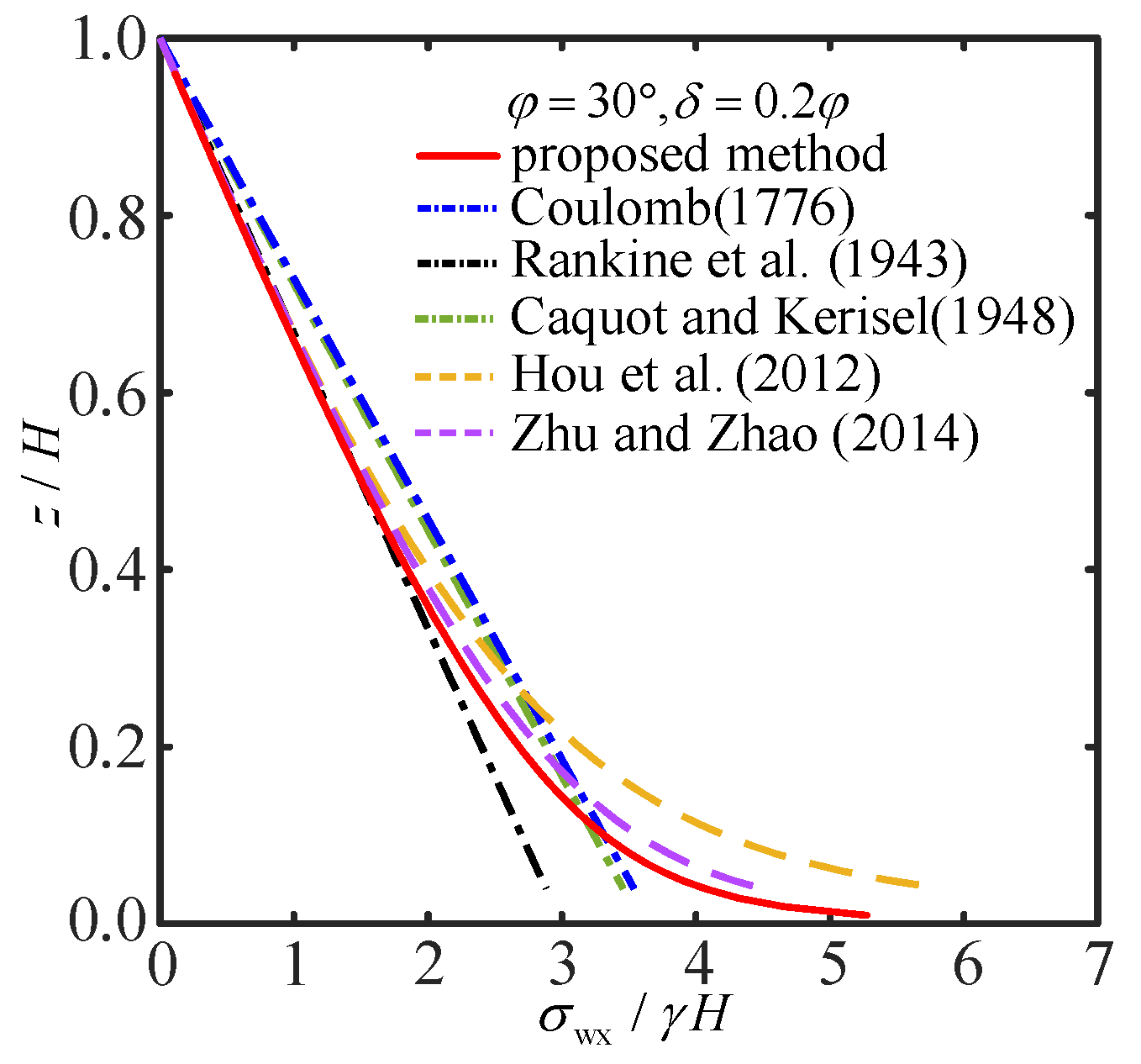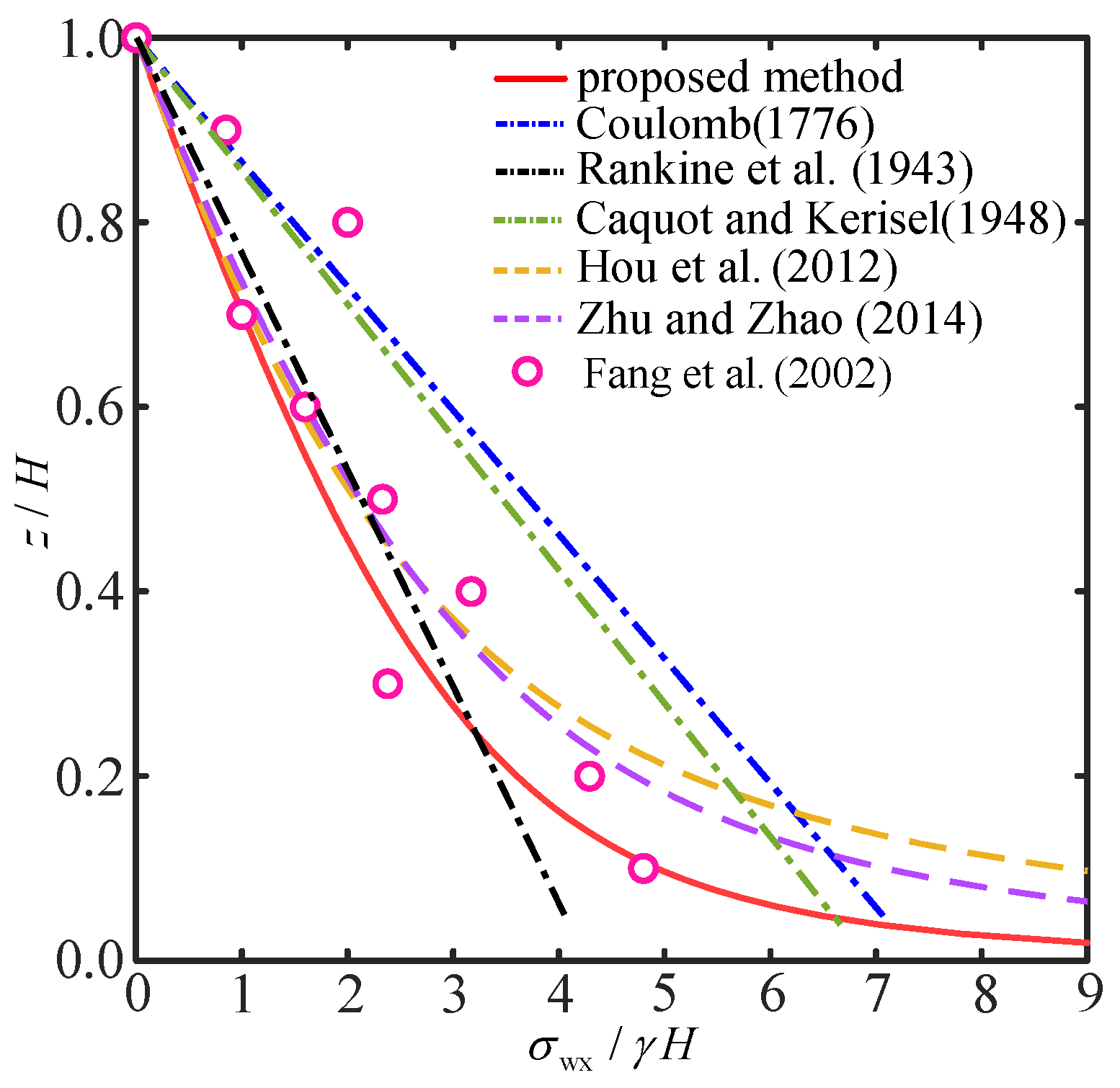Passive Earth Pressure and Soil Arch Shape: A Two-Dimensional Analysis
Abstract
1. Introduction
2. Derivation of Equilibrium Differential Equations and Solution for Passive Earth Pressure
2.1. Establishment of Equilibrium Differential Equations
2.2. Boundary Conditions
- (1)
- Upper Surface (z = H):
- (2)
- Soil–Wall Interface (x = 0):
- (3)
- Potential Sliding Surface ():
2.3. Solution of the Equilibrium Equations
2.4. Calculation of Passive Earth Pressure
3. Analysis of Soil Arching Under Passive Conditions
3.1. Derivation of Soil Arch Shape
3.2. Comparison with Circular and Parabolic Arches
- (1)
- Circular Arch
- (2)
- Parabolic Arch
4. Parametric Analysis
4.1. Soil Internal Friction Angle
4.2. Soil–Wall Interface Friction Angle
5. Comparison with Existing Theories and Experimental Data
6. Conclusions
- (1)
- Owing to the passive arching effect, the limit equilibrium state is achieved only locally near the wall back and lower sliding surface, which contrasts with methods that assume the entire wedge to be in a limit equilibrium state. The derived major principal stress varies in magnitude and direction at constant height.
- (2)
- The derived passive soil arch shape lies below conventional parabolic/circular assumptions, becoming significantly steeper with increasing soil–wall friction angle. Unlike fixed-geometry assumptions, it is also sensitive to surcharge, reflecting its dependence on the overall stress field.
- (3)
- The passive earth pressure coefficient increases with the internal friction angle and surcharge, consistent with established theories. However, it shows a non-monotonic relationship with the soil–wall friction angle, peaking at an intermediate value before decreasing.
- (4)
- Comparisons indicate the proposed method reasonably predicts pressure distributions observed in experiments, notably showing closer agreement in the lower wall regions than other theories.
Author Contributions
Funding
Institutional Review Board Statement
Informed Consent Statement
Data Availability Statement
Conflicts of Interest
References
- Caquot, A.; Kerisel, J. Tables for the Calculation of Passive Pressure, Active Pressure and Bearing Capacity of Foundations; Gauthier-Villars: Paris, France, 1948. [Google Scholar]
- Chang, M. Lateral earth pressures behind rotating walls. Can. Geotech. J. 1997, 34, 498–509. [Google Scholar] [CrossRef]
- Neal, T.S.O.; Hagerty, D.J. Earth pressures in confined cohesionless backfill against tall rigid walls—A case history. Can. Geotech. J. 2011, 48, 1188–1197. [Google Scholar] [CrossRef]
- Wang, Y. Distribution of earth pressure on a retaining wall. Géotechnique 2000, 50, 83–88. [Google Scholar] [CrossRef]
- Yang, Y.Z.; Wu, W.B.; Ni, F.F.; Mei, G.X. Pseudo-dynamic analysis of seismic non-limit passive earth pressure under the rb mode. Eng. Mech. 2023. [Google Scholar] [CrossRef]
- Handy, R.L. The arch in soil arching. J. Geotech. Eng. 1985, 111, 302–318. [Google Scholar] [CrossRef]
- Liu, H.; Kong, D.; Gan, W.; Wang, B. Seismic active earth pressure of limited backfill with curved slip surface considering intermediate principal stress. Appl. Sci. 2021, 12, 169. [Google Scholar] [CrossRef]
- Khosravi, M.H.; Kargar, A.R.; Amini, M. Active earth pressures for non-planar to planar slip surfaces considering soil arching. Int. J. Geotech. Eng. 2020, 14, 730–739. [Google Scholar] [CrossRef]
- Yu, P.; Liu, Y. Analysis of active earth pressure behind rigid retaining walls considering curved slip surface. Geotech. Geol. Eng. 2024, 42, 251–270. [Google Scholar] [CrossRef]
- Wang, X.; Dang, F.; Cao, X.; Zhang, L.; Gao, J.; Xue, H. Solution for Active and Passive Earth Pressure on Rigid Retaining Walls with Narrow Backfill. Appl. Sci. 2025, 15, 1750. [Google Scholar] [CrossRef]
- Hou, J.; Xia, T.D.; Kong, X.B.; Sun, M.M. Passive earth pressure on retaining walls calculated by principle of soil arching effect. Rock Soil Mech. 2012, 33, 2996–3000. [Google Scholar] [CrossRef]
- Zhu, J.M.; Zhao, Q. Unified solution to active earth pressure and passive earth pressure on retaining wall considering soil arching effects. Rock Soil Mech. 2014, 35, 2501–2506. [Google Scholar] [CrossRef]
- Patel, S.; Deb, K. Experimental and analytical study of passive earth pressure behind a vertical rigid retaining wall rotating about base. Eur. J. Environ. Civ. Eng. 2022, 26, 2371–2399. [Google Scholar] [CrossRef]
- Han, M.; Chen, X.; Jia, J. Analytical solution for displacement-dependent 3D earth pressure on flexible walls of foundation pits in layered cohesive soil. Acta Geotech. 2024, 19, 5249–5275. [Google Scholar] [CrossRef]
- Wang, Z.; Kang, W.; Chen, F.; Lin, C. Seismic passive earth pressures of narrow cohesive backfill against gravity walls using the stress characteristics method. Soils Found. 2024, 64, 101505. [Google Scholar] [CrossRef]
- Tracy, F.T.; Vahedifard, F. Analytical solutions for coupled hydromechanical modeling of lateral earth pressures in unsaturated soils. Comput. Geotech. 2025, 179, 107038. [Google Scholar] [CrossRef]
- Hu, W.; Hu, T.; Lin, S.; Tang, J.; Zhou, Y.; Hu, Q. Experimental Study on Deformation and Passive Earth Pressure Behind Cantilever Pile Retaining Walls in Narrow Excavations. Geotech. Geol. Eng. 2024, 42, 7041–7061. [Google Scholar] [CrossRef]
- Dang, F.; Wang, X.; Cao, X.; Gao, J.; Ding, J.; Zhang, L. Calculation method of earth pressure considering wall displacement and axial stress variations. Appl. Sci. 2023, 13, 9352. [Google Scholar] [CrossRef]
- Xu, J. Investigation into the Displacement-Dependent Lateral Earth Pressure on the Rigid Retaining Wall with Different Modes of Movement: Modeling with the Trigonometric Function. Int. J. Geomech. 2023, 23, 04023166. [Google Scholar] [CrossRef]
- Li, D.Y.; Ma, Z.H.; Liu, J.; Yin, J.L.; Sun, B.Y. Seismic Rotation Stability of Retaining Wall with Cohesive-frictional Backfill Considering Embedment Depth. Chin. J. Geotech. Eng. 2025. Online. [Google Scholar] [CrossRef]
- Wu, K.; Yu, P.; Liu, Y. Simulation of Passive Earth Pressure against Retaining Wall Considering Wall Movement Mode. IOP Conf. Ser. Earth Environ. Sci. 2021, 714, 022002. [Google Scholar] [CrossRef]
- Sahoo, J.P.; Ganesh, R. Discussion of “Estimation of Passive Earth Pressure against Rigid Retaining Wall Considering Arching Effect in Cohesive-Frictional Backfill under Translation Mode” by Yanyan Cai, Qingsheng Chen, Yitao Zhou; Sanjay Nimbalkar, and Jin Yu. Inter. Int. J. Geomech. 2018, 18, 07018011. [Google Scholar] [CrossRef]
- Dalvi, R.S.; Pise, P.J. Analysis of Arching in Soil-Passive State. Indian Geotech. J. 2012, 42, 106–112. [Google Scholar] [CrossRef]
- Janssen, H.A. Versuche uber Getreidedruck in Silozellen. Z. Ver. Deut. Ing. 1895, 39, 1045–1049. [Google Scholar]
- Jaky, J. Pressure in Silos. In Proceeding of the 2nd International Conference on Soil Mechanics and Foundation Engineering, Rotterdam, The Netherlands, 21–30 June 1948; pp. 103–107. [Google Scholar]
- Pipatpongsa, T.; Heng, S. Granular Arch Shapes in Storage Silo Determined by Quasi-static Analysis under Uniform Vertical Pressure. J. Solid Mech. Mater. Eng. 2010, 4, 1237–1248. [Google Scholar] [CrossRef]
- Fang, Y.S.; Ho, Y.C.; Chen, T.J. Passive Earth Pressure with Critical State Concept. J. Geotech. Geoenviron. 2002, 128, 651–659. [Google Scholar] [CrossRef]





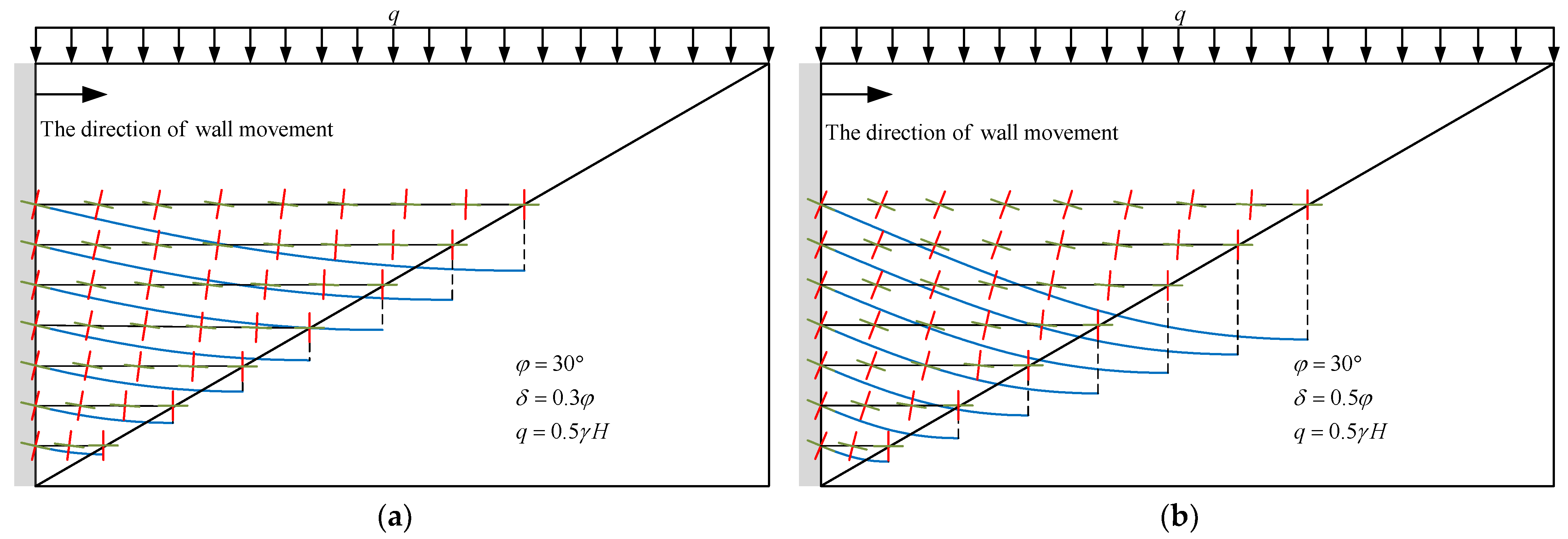

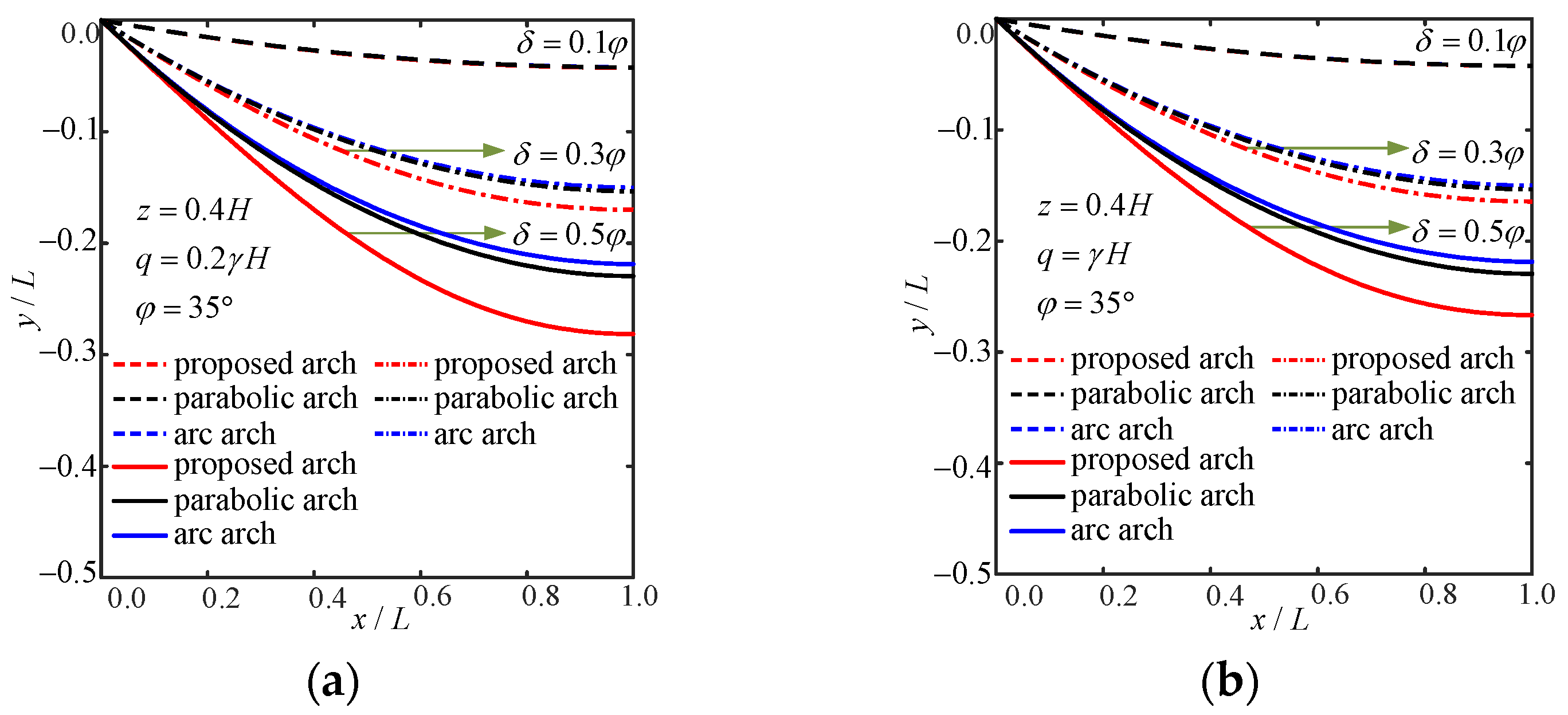

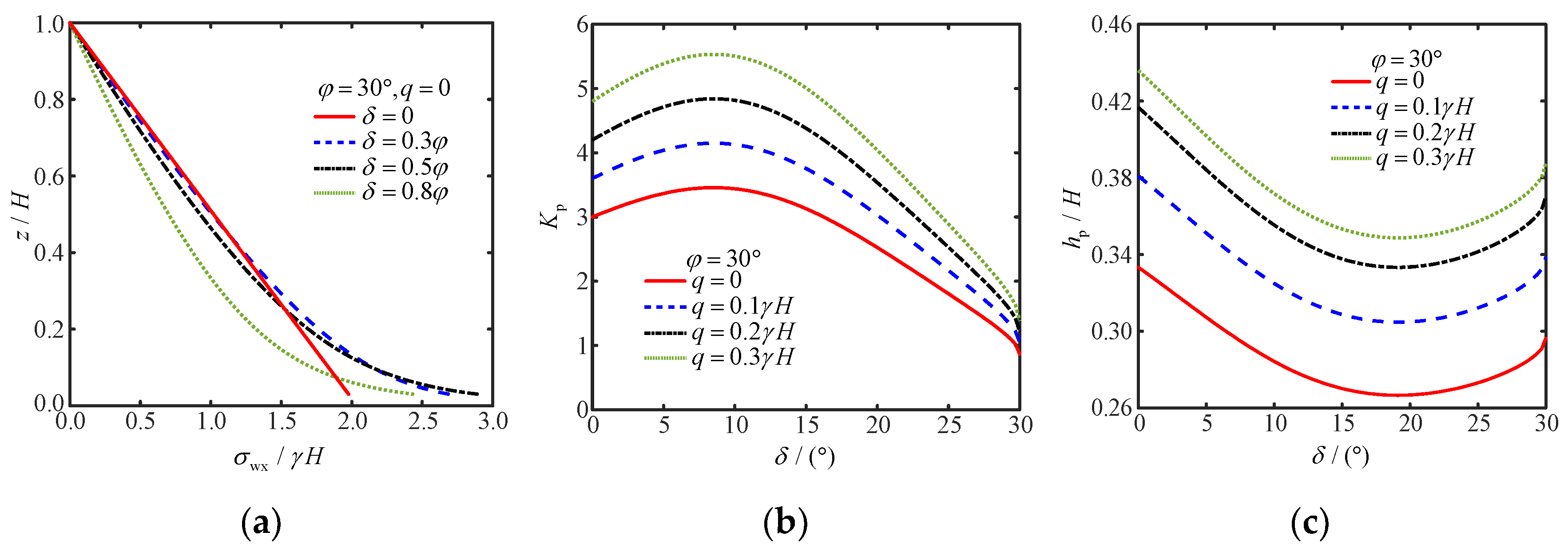
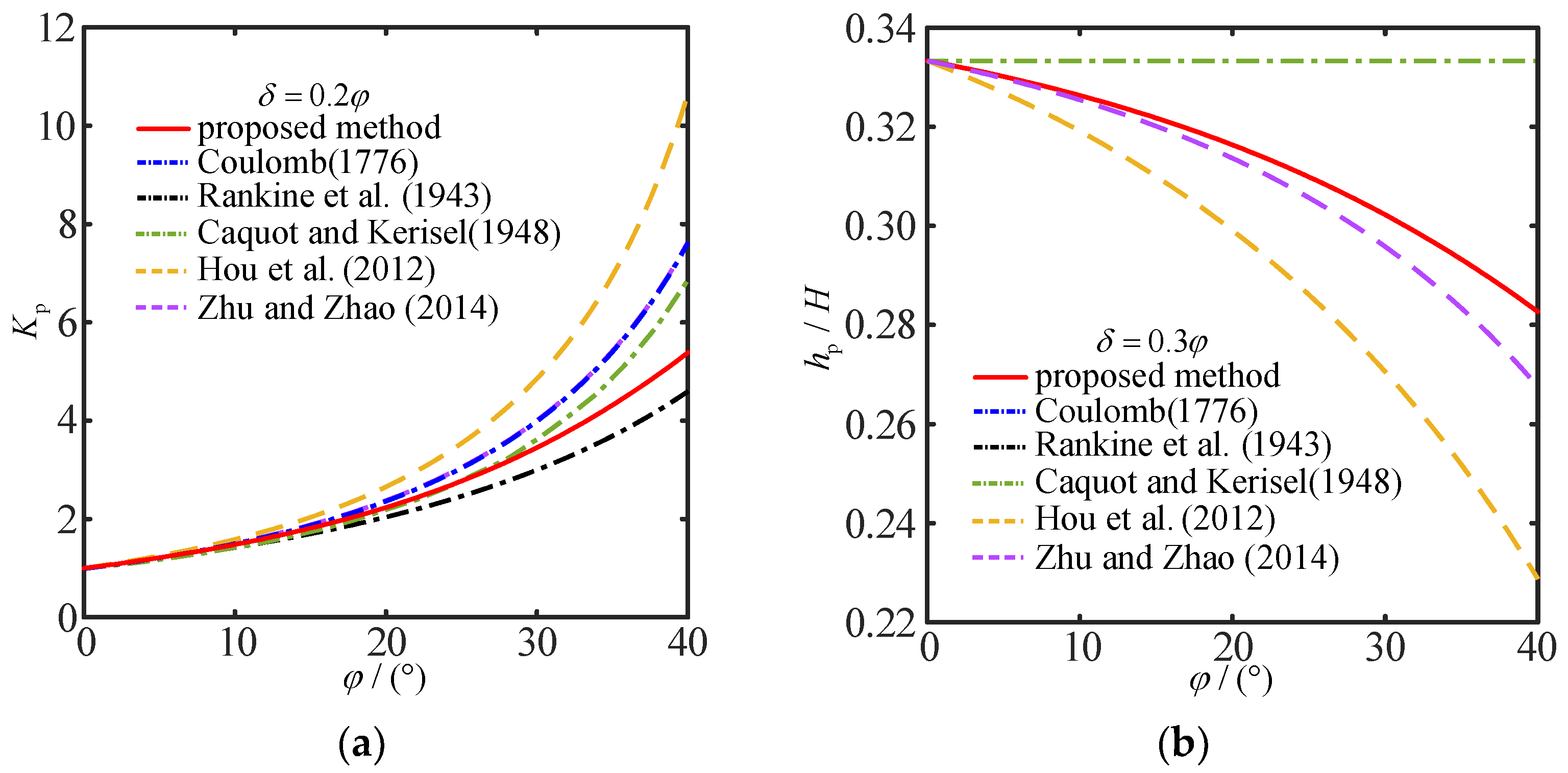

| Proposed Method | Coulomb | Rankine | Caquot and Kerisel [1] | Hou et al. [11] | Zhu and Zhao [12] | |
|---|---|---|---|---|---|---|
| SSE for earth pressure | 3.9272 | 21.9925 | 4.2317 | 14.7391 | 6.6133 | 5.149 |
| R2 for earth pressure | 0.8108 | −0.0595 | 0.7961 | 0.2899 | 0.6814 | 0.7519 |
| Application height error (%) | −10.12 | 13.07% | 13.07 | 13.07 | −45.33 | −24.31 |
Disclaimer/Publisher’s Note: The statements, opinions and data contained in all publications are solely those of the individual author(s) and contributor(s) and not of MDPI and/or the editor(s). MDPI and/or the editor(s) disclaim responsibility for any injury to people or property resulting from any ideas, methods, instructions or products referred to in the content. |
© 2025 by the authors. Licensee MDPI, Basel, Switzerland. This article is an open access article distributed under the terms and conditions of the Creative Commons Attribution (CC BY) license (https://creativecommons.org/licenses/by/4.0/).
Share and Cite
Yu, P.; Wu, K.; Li, D.; Liu, Y. Passive Earth Pressure and Soil Arch Shape: A Two-Dimensional Analysis. Appl. Sci. 2025, 15, 6345. https://doi.org/10.3390/app15116345
Yu P, Wu K, Li D, Liu Y. Passive Earth Pressure and Soil Arch Shape: A Two-Dimensional Analysis. Applied Sciences. 2025; 15(11):6345. https://doi.org/10.3390/app15116345
Chicago/Turabian StyleYu, Pengqiang, Kejia Wu, Dongsheng Li, and Yang Liu. 2025. "Passive Earth Pressure and Soil Arch Shape: A Two-Dimensional Analysis" Applied Sciences 15, no. 11: 6345. https://doi.org/10.3390/app15116345
APA StyleYu, P., Wu, K., Li, D., & Liu, Y. (2025). Passive Earth Pressure and Soil Arch Shape: A Two-Dimensional Analysis. Applied Sciences, 15(11), 6345. https://doi.org/10.3390/app15116345






